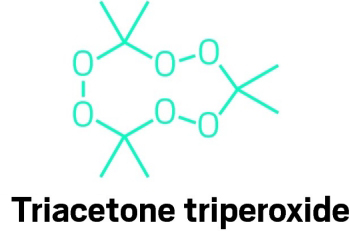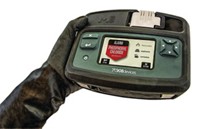Advertisement
Grab your lab coat. Let's get started
Welcome!
Welcome!
Create an account below to get 6 C&EN articles per month, receive newsletters and more - all free.
It seems this is your first time logging in online. Please enter the following information to continue.
As an ACS member you automatically get access to this site. All we need is few more details to create your reading experience.
Not you? Sign in with a different account.
Not you? Sign in with a different account.
ERROR 1
ERROR 1
ERROR 2
ERROR 2
ERROR 2
ERROR 2
ERROR 2
Password and Confirm password must match.
If you have an ACS member number, please enter it here so we can link this account to your membership. (optional)
ERROR 2
ACS values your privacy. By submitting your information, you are gaining access to C&EN and subscribing to our weekly newsletter. We use the information you provide to make your reading experience better, and we will never sell your data to third party members.
Analytical Chemistry
Finding Weapons
Forensic Science Center scientists tackle a number of chemical challenges
by Jyllian Kemsley
August 25, 2008
| A version of this story appeared in
Volume 86, Issue 34

WHEN THE CHEMICAL Weapons Convention (CWC) was ratified in 1997 to destroy existing stockpiles of weapons and prevent the production of new ones, the Organisation for the Prohibition of Chemical Weapons (OPCW) was established to oversee implementation of the treaty. As part of OPCW's mission, it sends inspectors to countries to check for CWC compliance. It also certifies laboratories around the world to analyze samples obtained by inspectors.
The Forensic Science Center (FSC) at Lawrence Livermore National Laboratory (LLNL), in California, is one of 16 labs worldwide—and one of two in the U.S., the other being the Army's Edgewood Chemical Biological Center, in Maryland—currently certified by OPCW to analyze chemical weapons samples. FSC is also the only lab in the U.S. that can handle forensic samples relating to the full range of threats—chemical, biological, radiological, nuclear, and explosive—collectively known under the term weapons of mass destruction (WMD).
The center's dozen staff members use world-class instrumentation—some of which is only available on-site at LLNL—to tackle some of the nation's most difficult forensic science problems. They participate in current investigations of criminal or terrorist events and in research and development efforts aimed at preventing incidents. And whether FSC is analyzing chemical weapons samples, identifying drugs in cadavers, or finding new ways to detect chemical or explosive agents, chemistry is central to much of its work.
FSC's most important role is perhaps its ability to handle chemical weapons samples for OPCW. As part of that effort, FSC participates in annual tests when the OPCW labs are checked on their ability to identify not only key chemical weapons agents but also the agents' raw materials, precursors, and decomposition products. Not counting enantiomers, the labs must be on the lookout for about 12,000 potentially dangerous chemicals.
Missing as few as two or three chemicals present in the test samples can result in an OPCW lab's certification being suspended pending the next round of tests. Reporting merely one false positive results in a lab losing its certification entirely. FSC Director Dennis J. Reutter, who served as a Department of Defense representative in The Hague when the CWC was implemented, notes that "when we set the rules, we set the bar very high." The results of chemical weapons inspections can, after all, lead to economic sanctions or military action against a country.
The samples, prepared by another OPCW lab, are designed to be difficult to analyze. They can take the form of liquids or emulsions, or chemicals can be spiked into media such as soil samples. Diesel fuel and other substances are often added to make analysis more difficult. The labs get 15 calendar days to analyze the samples by whatever means they have available. At FSC that typically means various combinations of elemental analysis, nuclear magnetic resonance, liquid chromatography, and various gas chromatography (GC) techniques such as GC-mass spectrometry (GC/MS), GC/MS-chemical ionization, GC/MS-electron impact, or GC-infrared spectroscopy.

Often, chemical intuition comes into play. In the last testing round, in late 2007, one chemical came up that the scientists weren't sure about, "but it looked kind of suspect," FSC chemist Armando Alcaraz says. FSC chemical information specialist Amal Moulik eventually found a literature reference to the compound as a precursor to an agent similar to the nerve toxin tabun. In another case, FSC scientists spent a week identifying a compound that had an elemental composition similar to a VX-type nerve agent. In the end, they determined that it was just a red herring spiked into the sample to challenge the analysts.
MAINTAINING A LAB with the personnel and equipment to do high-level, diverse, and potentially classified chemical weapons work that could be used to inform national security decisions—and keep it all available on a moment's notice—is an expensive task. Adding to the challenge is that although FSC is located at LLNL and uses some of the facility's equipment and expertise, it does not receive any of LLNL's Department of Energy (DOE) funding for operations and maintenance because forensics is not part of DOE's mission. Instead, FSC is paid by the job. "I've made the analogy that it's a bit like running a firehouse and being paid per fire," Reutter says. "It's a challenging business model." OPCW-specific work is funded by DOE's Office of Dismantlement & Transparency. To further maintain its resources, the center takes on projects from various agencies that advance national security goals without being directly related to an investigation. The agencies the center works with include the Department of Homeland Security, the Federal Bureau of Investigation, the Food & Drug Administration, and the Environmental Protection Agency.
For example, FSC is working on an EPA contract to identify what happens when a chemical or biological weapon is released inside a building. Does the agent degrade? How does it or its degradation products interact with the materials inside the facility, and what can be cleaned up or what needs to be destroyed? The resulting information should help EPA with its mission to clean up after any WMD incidents.
The results of these studies can also guide sample collection for forensics analysis to identify the perpetrator in the event of a WMD attack, Reutter notes, in that if you know where the agent goes, then you know where to sample. "It doesn't do a lot of good to look for chemical agents on the face of stainless steel, since stainless steel doesn't collect them, but chair upholstery made from polyurethane acts like a sponge," he adds.
FSC is also developing new ways to detect WMD. The result of one of those projects, done with a research grant from DOE's National Nuclear Security Administration, is the Easy Livermore Inspection Test for Explosives (ELITE), a palm-sized device that can detect more than 30 different explosives.
ELITE is designed to be quick and easy to use: A first responder such as a police or military officer removes a tab from the ELITE card, swipes it on the suspect surface, and then puts the tab back into the card. The officer then breaks one of two glass vials, releasing a nucleophile that reacts with the phenyl group of trinitrotoluene (TNT) or similar materials to form a complex that creates an intense color on the card.
If the TNT test is negative, the officer can then break the second vial to release a reagent that reacts with organic nitrite compounds to form a pink diazonium dye. This part of the test could detect military explosives such as RDX or HMX, as well as ammonium nitrate and pentaerythritol tetranitrate, one of the ingredients in the plastic explosive Semtex. As first responders "the users don't care what kind of explosives there are, just that they're there," LLNL scientist and former FSC Director John G. Reynolds says. So having a simple system with a color change to give a positive result is key, he says, as is having the unit be small and self-contained. Field Forensics, in St. Petersburg, Fla., licensed the technology and brought the devices to the commercial market in late 2007.
Under a separate DOE contract, FSC has also developed a chemical vapor sensor that can detect a variety of chemical substances, including agents such as VX and mustard gas. The sensor unit is composed of an array of microcantilevers–"little silicon diving boards," says FSC scientist Bradley R. Hart, who led the project–that are each coated with a different polymer (Analyst 2008, 133, 608). The polymers are not selective for individual chemicals but rather react differently with individual compounds. When the polymers react, they cause the cantilever to bend, which changes the electrical resistance. The overall pattern leads to a fingerprint of sorts for an individual chemical; complex mixtures can be deconvoluted by a computer program.
The sensor is designed to be a "set it and forget it" device that could be placed to monitor buildings or pipelines. It has low power needs and no consumables to be replaced. The group is now working to adapt the technology to detect analytes with low volatility such as pesticides, FSC postdoc Albert Loui says. As part of that effort, the researchers are looking at coating the cantilevers with high-surface-area materials such as functionalized aerogels or metal nanoparticles in a polymer matrix that would be capable of picking up very low concentrations of material.
Although FSC has separate funding and projects from its neighbor labs at LLNL, FSC's placement within the facility gives it ready access to resources that can be key to WMD forensics. In particular, the knowledge of the nuclear weapons staff comes to bear during analysis of the origin of a nuclear or radiological device. LLNL also has significant systems modeling expertise such that "if you can imagine a device, you can predict how it will behave and what its impact will be in a number of different environments," Reutter says. Additionally, FSC worked with LLNL's Energetic Materials Center on the ELITE project, whereas LLNL's Center for Accelerator Mass Spectrometry offers FSC staff the opportunity to do extremely precise radionuclear dating on very small samples.
Ultimately, Reutter hopes, the value in FSC will not be so much about identifying WMD, finding terrorists, or helping to clean up after incidents as it will be about deterring attacks in the first place. "That's certainly what I think is most important about having a robust forensics capability for WMD" at FSC, he says. "You can't think that you can do something and be anonymous about it. We will know how the material was made and what starting products were used. Working with law enforcement investigators, it is possible to find out where the material was made and by whom. To some groups, that will be a significant deterrent."
- Finding Weapons
- Forensic Science Center scientists tackle a number of chemical challenges
- FSC Provided Vital Link To Serial Killer
- One investigation FSC worked on was the case of Los Angeles-area serial killer Efren Saldivar, a respiratory therapist known as the "Angel of Death"







Join the conversation
Contact the reporter
Submit a Letter to the Editor for publication
Engage with us on Twitter